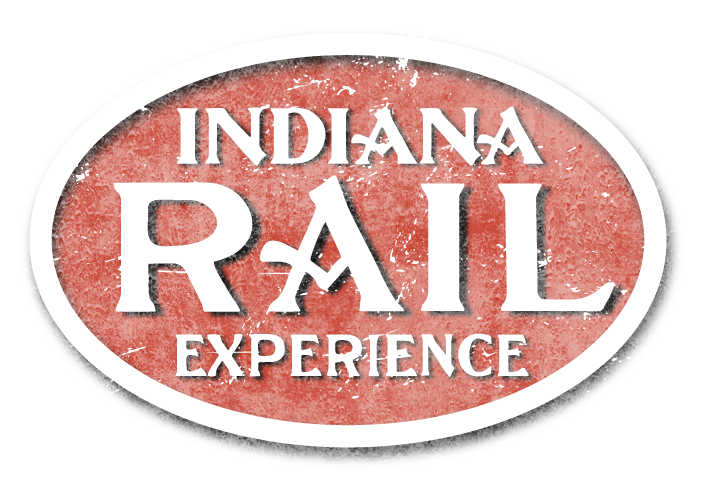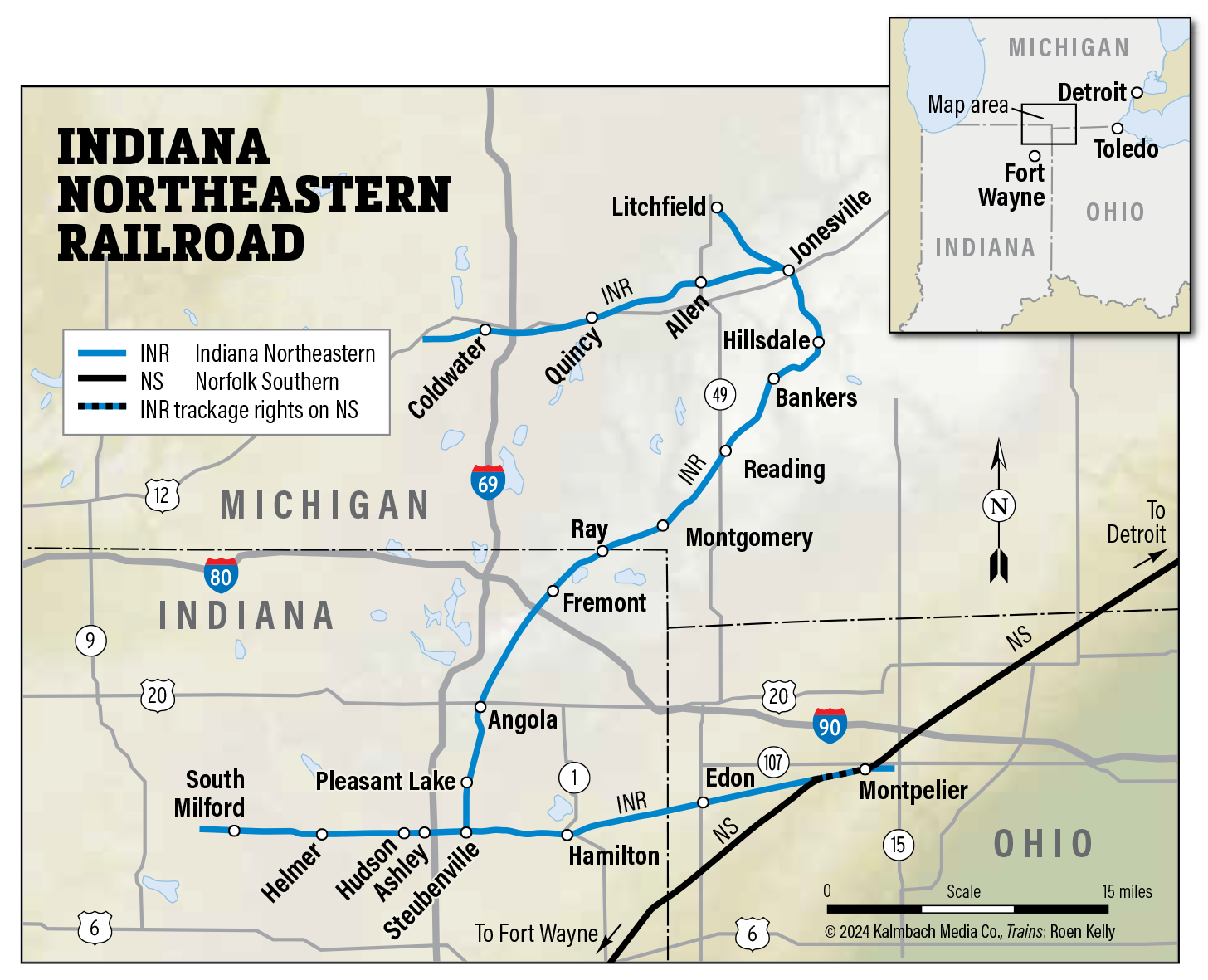THE NEW YORK CENTRAL ROUTE
Steubenville – Located at the southernmost point in Steuben County, the New York Central’s former Fort Wayne and Jackson Railroad (FW&J) crossed the Wabash Railroad’s Fourth District at grade. Constructed in 1872, the FW&J ran between its namesake cities. As freight railroads suffered mergers and bankruptcies in the 1960s, trackage from Steubenville south to Fort Wayne was conveyed from New York Central to Penn Central, and finally to Conrail in the 1970s and eventually removed. From Steubenville to Hillsdale, Michigan, the tracks are still in place and are operated by the Indiana Northeastern.
At Hillsdale, the former FW&J trackage intersects with a former New York Central line known as “The Old Road.” This line was so-named, as it was the first line to reach Chicago from the east but was later supplanted as the main line from Buffalo to Chicago by predecessor Lake Shore and Michigan Southern (LS&MS) when they built the “Air Line” between Toledo and Elkhart. The Indiana Northeastern operates this line to the west side of Coldwater, Michigan.
Pleasant Lake, Indiana – Pleasant Lake is a quiet lakeside community that was once a prosperous resort town, which included an icehouse for ice harvested from the adjacent lake, two large gravel pits that supplied thousands of carloads to the railroad, and a brickyard, stockyard, and lumber yard. Constructed in 1882, the original LS&MS combination freight house and passenger station still stands and is listed on the National Register of Historic Places. Directly across the tracks from the depot, one can still see the concrete foundations of the large water tank for the railroad. The railroad crosses Pigeon Creek, which connects to Long Lake and finally Mongo, Indiana.
Angola, Indiana – Founded in 1838 and named after Angola, New York, this town is best known as the home of Trine University, which began as Tri-State Normal College. Angola’s Civil War memorial on the city square includes the names of all 1,278 locals who fought for the Union.
Angola’s County Court House dates from 1868 and is on the National Register of Historic Places. The weathervane atop the cupola is topped not with a rooster but with a fish, which is appropriate given that Steuben County is home to “101 lakes.”
Pokagon State Park is located on nearby Lake James and is home to a refrigerated Toboggan slide and the Pottowotamie Inn.
The St. Joe Valley Interurban entered Angola from the Northwest and crossed under the FtW&J on the north side of the N. Wayne St. (SR 127) crossing.
Fremont, Indiana – Founded in 1834 as Willow Prairie, then as Brockville, and finally renamed Fremont in 1848, the town is located on the Vistula Trail (present-day SR 120). The railroad serves a plastics plant and a commercial bakery here.
Ray, Indiana/Michigan – Straddles the state line and had its own Post Office from the time the railroad came through, in 1872, until 1960. Ray once had several stores, a mill, and a school. It is now an ideal spot for photo runbys during all-day passenger excursions to and from Hillsdale.
Montgomery, Michigan – Originally known as “Frog Eye” and founded at about the time the railroad came through. Montgomery was meant to be the junction for the Mansfield and Coldwater Railroad which was graded but never completed. A sharp eye can spy the grade on the west edge of town where it would have crossed the Fort Wayne and Jackson.
Reading, Michigan – Originally known as “Basswood Corners,” Reading (pronounced “REED-ing”) is home to Indiana Northeastern’s largest customer, The Anderson’s Trade Group, which supplies thousands of carloads of soybeans and corn originate here each year.
Bankers, Michigan – Once a junction point on the railroad, the original route of the FW&J bypassed Hillsdale and continued directly to Jonesville, Michigan. To the northeast of this junction was the Detroit, Hillsdale, and Southwestern. When the LS&MS took control of both of these lines, they utilized the Detroit, Hillsdale, and Southwestern line to reach Hillsdale. Beyond Hillsdale to the east, this railroad was operated as the Ypsilanti Branch.
Hillsdale, Michigan – County Seat of Hillsdale County and home of Hillsdale College, founded by Freewill Baptists in 1844. The Michigan Southern Railroad reached Hillsdale that same year. Due to financial difficulties, it did not progress west of Hillsdale until 1850. Michigan Southern reached Chicago in 1852.
Hillsdale is the former headquarters of the Lansing Division of the New York Central. The town was the site of a small yard and included a roundhouse and turntable. The New York Central ran trains in five directions and the town once saw 16 regularly scheduled passenger trains each day. The railroad’s station, division headquarters building and the freight house have survived to this day. The freight house has recently been acquired for redevelopment.
The railroad previously served a large flour mill that was closed by Pillsbury in 2003. In 2022, Nickel Plate Road steam locomotive no. 765 was the largest steam locomotive to operate in Hillsdale since the New York Central retired its fleet of steam locomotives in the 1950s.
Jonesville, Michigan – Jonesville was another cross-section of the New York Central’s Michigan railroads and a 140-year-old railroad depot still exists today as a bed and breakfast.
Quincy, Michigan – Settled in 1830 and named for Quincy, Massachusetts, this town was one of several that popped up along the Sauk Trail, which was later commonly known as the Chicago Road between Chicago and Detroit. Quincy is the run-around point for the Little River Railroad, a local heritage railroad, which delivers its train riders to a local park.
Coldwater Michigan – Originally named Masonville, Coldwater is the headquarters of the Little River Railroad, which maintains a historic Lake Shore depot at its boarding site.
Coldwater and Hillsdale are the eastern and western points of the Indiana Northeastern’s Michigan trackage, but pieces of the original New York Central line remain in service but just out of reach in Adrian and White Pigeon, Michigan. Unfortunately, you can no longer get to these places on the “Old Road.”
THE WABASH ROUTE
The former Wabash trackage begins at a point a mile west of Montpelier, Ohio known as “Pergo.” This was the beginning of the Wabash’s Fourth District. Norfolk Southern abandoned most of the Fourth District, but the largest remaining portion totals 37.5 miles and is operated by the Indiana Northeastern. The Indiana Northeastern interchanges all of its traffic with Norfolk Southern and the general railroad system at a yard in Montpelier.
Edon, Ohio – The Wabash’s Fourth District was constructed through this town in 1893, just in time for the line to be used to ferry people to Chicago’s great Colombian Exposition. Many special passenger trains were run across this line in its first year of operation. The original Wabash passenger station was relocated several times and is preserved in a city park.
Edon is home to a large farmer’s cooperative which has an elevator near downtown Edon that supplies the Indiana Northeastern with hundreds of loads annually. The Co-Op also has a fertilizer plant two miles east of Edon that receives hundreds of loaded tanks and hoppers annually.
Hamilton, Indiana – This community on Steuben/DeKalb County line prospered greatly when its small mill pond became a much larger lake upon which a great many cottages and lake homes were built. It currently has two passing tracks that are frequently used by Indiana Northeastern crews to classify their trains as well as to swap blocks.
Ashley, Indiana – Ashley began life as a “Company Town” and bears the name of O.D. Ashley, president of the Wabash Railroad, which was built between 1892-1893. It served as the original division point for the Wabash, as it was about halfway between Detroit and Chicago. In 1907, the division point was relocated to Montpelier, Ohio, and with it went the roundhouse, yard, and dozens of employees. Currently, there are five customers in Ashley for the Indiana Northeastern.
Hudson, Indiana – a neighboring community of Ashley, this is a typical Indiana farming town and home to the locomotive shop and maintenance building for Indiana Northeastern. The railroad crews perform everything from routine inspections to complete rebuilds of locomotives here.
Helmer, Indiana – Helmer is home to a long-passing siding and was the starting point of the Wabash branch to Stroh, Indiana, which was built to serve the town’s cement plant.
South Milford, Indiana – South Milford is a small, unincorporated village and home to South Milford Grain. The railroad line ends two miles west of the grain elevator, which supplies thousands of loads of corn, beans, and wheat each year.

